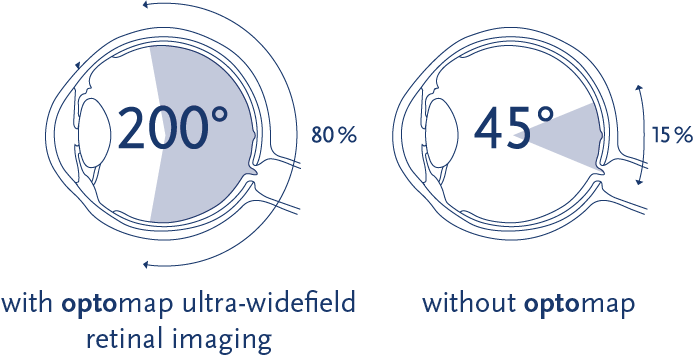One of the questions ocular health practitioners ask about ultra-widefield retinal imaging (UWF™) is regarding the justification of a voluntary procedure that entails added cost. Will patients really be interested in a new and possibly unfamiliar diagnostic procedure that’s not covered by insurance?

200 vs. 45 degree view.
The core issue is patient perception. If a procedure is not paid for by insurance, is it really necessary? Here are some practical suggestions about how to talk to your patients about the importance of optomap.
The Patient Wants to Hear From You
While your office staff are an important part of your practice, your patients want your opinion. Even if your staff has already discussed optomap with the patient, take the time to personally explain how optomap works and its benefits. Focus on the advantages over conventional imaging, including ease of use, a wider field of view, and the ability to review and store high-resolution images.
Your personal attention to your patients’ questions and your own enthusiasm about the technology will send a powerful message.
What About Scripts?
Every practice can benefit from the use of scripts to guide discussions about the use of UWF imaging. This helps assure patients get concise, accurate information about their healthcare decisions. Staff training can help address this, but what’s also needed is practice and discussion. Talk with your staff about your patients’ questions and concerns, and adjust your scripts to what works best for you and your team.
We advise all practices that the most effective way of introducing optomap and gaining patient acceptance is by educating everyone in the practice that optomap is the standard of care within your practice as well as an integral part of your eye exam regimen.
Every Doctor Has a Story
It’s one thing to read about a patient’s optomap story. It’s another to tell your patient about the retinal tear you found in a 67-year-old grandfather. Letting patients hear case histories of other patients whose vision has been saved with the help of optomap is useful. Your personal experiences are of far more interest to your patients than a brochure. Emphasize that the vast majority of your patients have normal optomap findings.
Why Isn’t optomap a Covered Procedure?
Some of your patients may question you on this point. Most of them may never have been offered a medical test that’s not covered by insurance. Explain to them that optomap can provide additional diagnostic information above what is seen during a traditional examination.
Seeing Is Believing
Showing the physical differences between small-field imaging and UWF imaging can have a big impact on patient decision-making. Make this is an important part of the discussion with your patient. Continue to highlight the benefits of optomap during the consultation period and add personalization by utilizing 3D wrap, and walking the patient through what is on their retina.
It’s also important to emphasize how, over time, optomap can monitor changes in the eye that conventional methods can’t. This high-resolution, digital record can give patients both peace of mind and an early warning of potential problems. By taking the time to review the results your patient will walk out of your office confident that they’ve made a good healthcare decision.
About optomap and Ultra-widefield Retinal Imaging
UWF imaging technology gives ocular health practitioners imagery and diagnostic information about the retinal periphery that can’t be provided by small-field imaging methods. UWF retinal imaging technology from Optos is a multi-modal platform which is a customizable solution for use in multiple eyecare settings.


